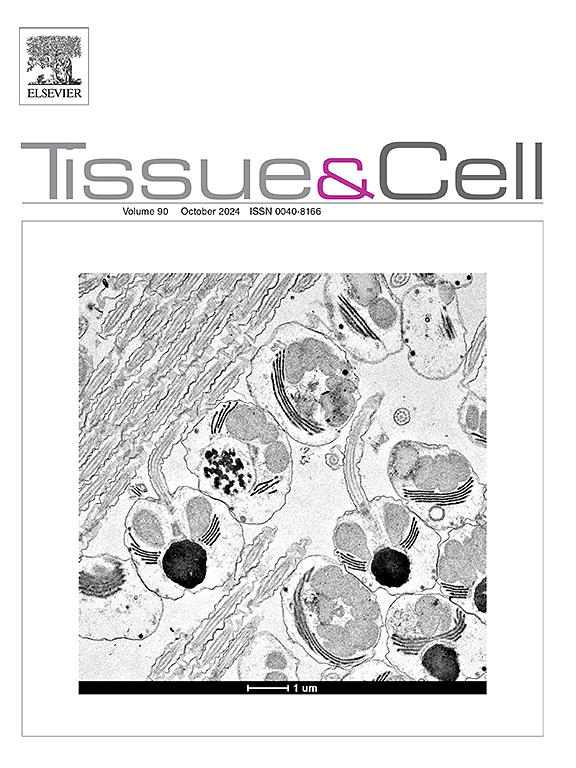A new anatomical insight into the architecture of biliary duct system, gall bladder, and Duodenal Papilla with the extrahepatic bile ducts of white pekin duck (Anas platyrhynchos)
IF 2.7
4区 生物学
Q1 ANATOMY & MORPHOLOGY
引用次数: 0
Abstract
The study was prepared to explain the morphological features of the biliary duct system, gall bladder, duodenal papilla, extrahepatic ducts, and pancreatic ducts of the white Pekin Duck (Anas platyrhynchos) using gross, casting, ultrastructural, and histochemical techniques. The gall bladder in the liver's cystic fossa is not visible from the right lobe's parietal surface. Bile is drained from the liver via the intrahepatic bile duct, with one main duct in the left lobe branched into two secondary ducts and three hepatic ducts in the right lobe. The hepatocystic duct transports bile to the gall bladder, joins the hepatic ducts, and opens in the bile sinus. The duodenal papilla is a small, non-elevated structure in the duodenal mucosal lining, containing the glands and surrounded by columnar epithelial cells and thick microvilli. The pancreatic ducts, surrounded by a thick muscular layer and opening on the elevated side of the papilla, is lined with simple epithelium and goblet cells, with microvilli. The gall bladder is composed of tunica mucosa, muscularis, serosa, and adventitia, with a simple columnar epithelium, small brush borders, and a striated border of microvilli. The hepatoenteric duct is covered by simple cuboidal epithelium, and the mucosa forms folds along its luminal surface without the mucosa lamina muscularis. The cystoenteric duct is lined with tall columnar epithelium, with a twisted wall and numerous smooth muscle fibers. PAS exhibited positive reactions for all structures. In conclusion, research on the duck biliary system is vital for understanding avian digestive mechanisms, benefiting veterinary medicine and conservation efforts.
白北京鸭肝外胆管的胆管系统、胆囊和十二指肠乳头结构的解剖学新认识
本研究采用大体、铸型、超微结构和组织化学技术,对白北京鸭(Anas platyrhynchos)的胆管系统、胆囊、十二指肠乳头、肝外管和胰管的形态学特征进行了研究。肝囊窝内的胆囊从右肝叶壁面看不见。胆汁经肝内胆管排出肝脏,肝内胆管在左叶有一条主胆管,在右叶有两条次级胆管和三条肝管。肝囊管将胆汁运送到胆囊,与肝管相连,并在胆窦打开。十二指肠乳头是十二指肠粘膜衬里的一个小的、非隆起的结构,包含腺体,被柱状上皮细胞和厚微绒毛包围。胰管被一层厚实的肌肉层包围,在乳头隆起的一侧开口,内衬单层上皮和杯状细胞,并有微绒毛。胆囊由膜粘膜、肌层、浆膜和外膜组成,单层柱状上皮,小刷状边界,微绒毛条纹边界。肝肠管被单方上皮覆盖,粘膜沿其管腔表面形成褶皱,无粘膜肌层。囊肠管内衬高柱状上皮,壁扭曲,有大量平滑肌纤维。PAS对所有结构均表现出正反应。总之,研究鸭的胆道系统对于了解鸟类的消化机制,有利于兽医和保护工作至关重要。
本文章由计算机程序翻译,如有差异,请以英文原文为准。
求助全文
约1分钟内获得全文
求助全文
来源期刊

Tissue & cell
医学-解剖学与形态学
CiteScore
3.90
自引率
0.00%
发文量
234
期刊介绍:
Tissue and Cell is devoted to original research on the organization of cells, subcellular and extracellular components at all levels, including the grouping and interrelations of cells in tissues and organs. The journal encourages submission of ultrastructural studies that provide novel insights into structure, function and physiology of cells and tissues, in health and disease. Bioengineering and stem cells studies focused on the description of morphological and/or histological data are also welcomed.
Studies investigating the effect of compounds and/or substances on structure of cells and tissues are generally outside the scope of this journal. For consideration, studies should contain a clear rationale on the use of (a) given substance(s), have a compelling morphological and structural focus and present novel incremental findings from previous literature.
 求助内容:
求助内容: 应助结果提醒方式:
应助结果提醒方式:


